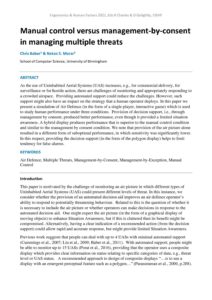| Document | Author Chris Baber & Natan S. Morar |
| Abstract As the use of Uninhabited Aerial Systems (UAS) increases, e.g., for commercial delivery, for surveillance or for hostile action, there are challenges of monitoring and appropriately responding to a crowded airspace. Providing automated support could reduce the challenges. However, such support might also have an impact on the strategy that a human operator deploys. In this paper we present a simulation of Air Defence (in the form of a single-player, interactive game) which is used to study human performance under three conditions. Provision of decision support, i.e., through management by consent, produced better performance, even though it provided a limited situation awareness. A hybrid display produces performance that is superior to the manual control condition and similar to the management by consent condition. We note that provision of the air picture alone resulted in a different form of suboptimal performance, in which sensitivity was significantly lower. In this respect, providing the decision support (in the form of the polygon display) helps to limit tendency for false alarms. |

